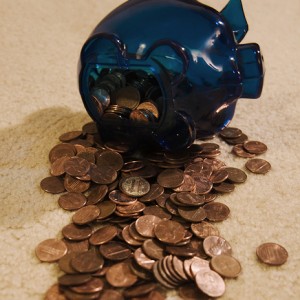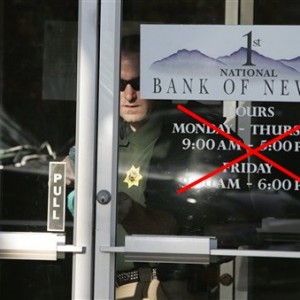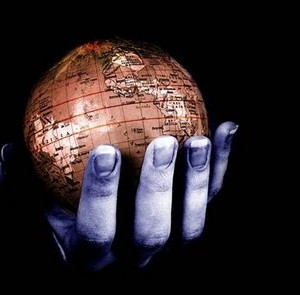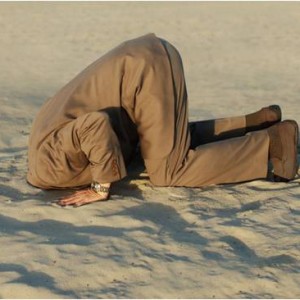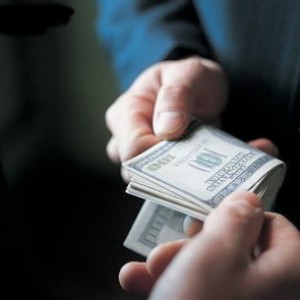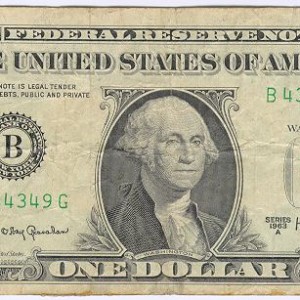 Millions of Americans are waking up to the fact that the Federal Reserve is bad, but very few of them can coherently explain why this is true. For decades, an unelected, privately-owned central bank has controlled America’s currency, run our economy and has driven the U.S. government to the brink of bankruptcy. It operates in great secrecy, it has never been subjected to a comprehensive audit and yet the actions it takes have an impact on every single American. It is an institution designed to drain wealth from the U.S. government (and ultimately from the American people) and transfer it to the ultra-wealthy. Have you ever wondered why a sovereign nation such as the United States has to borrow United States dollars from anyone? Have you ever wondered why a sovereign nation such as the United States does not even issue its own currency? Have you ever wondered why we allow a group of unelected private bankers to run our economy?
Millions of Americans are waking up to the fact that the Federal Reserve is bad, but very few of them can coherently explain why this is true. For decades, an unelected, privately-owned central bank has controlled America’s currency, run our economy and has driven the U.S. government to the brink of bankruptcy. It operates in great secrecy, it has never been subjected to a comprehensive audit and yet the actions it takes have an impact on every single American. It is an institution designed to drain wealth from the U.S. government (and ultimately from the American people) and transfer it to the ultra-wealthy. Have you ever wondered why a sovereign nation such as the United States has to borrow United States dollars from anyone? Have you ever wondered why a sovereign nation such as the United States does not even issue its own currency? Have you ever wondered why we allow a group of unelected private bankers to run our economy?
Those are some very important questions. Hopefully what you are about to read will open the eyes of many. The truth is that our financial system is centrally-controlled and centrally-managed by a group of banking oligarchs who have constructed an ever-expanding debt spiral which has been efficiently designed to slowly transfer all wealth into their hands.
The following are 11 reasons why the Federal Reserve is not good for the United States….
1 – The Federal Reserve was created as a way to enslave the U.S. government with debt. The truth is that the U.S. government only goes into debt if it chooses to. Theoretically, one day that U.S. government could simply decide to print as many U.S. dollars as it wants and pay off all government debts. But under the current system that is not allowed. You see, today the U.S. government does not issue any money. The Federal Reserve issues all money. That is why they are called “Federal Reserve notes”.
Under the current regime, whenever the U.S. government wants more currency to be created it has to go into more debt.
In a previous article entitled “It Is Now Mathematically Impossible To Pay Off The U.S. National Debt” I explained how this insidious system works….
If you will pull a dollar bill out and take a look at it, you will notice that it says “Federal Reserve Note” at the top.
It belongs to the Federal Reserve.
The U.S. government cannot simply go out and create new money whenever it wants under our current system.
Instead, it must get it from the Federal Reserve.
So, when the U.S. government needs to borrow more money (which happens a lot these days) it goes over to the Federal Reserve and asks them for some more green pieces of paper called Federal Reserve Notes.
The Federal Reserve swaps these green pieces of paper for pink pieces of paper called U.S. Treasury bonds. The Federal Reserve either sells these U.S. Treasury bonds or they keep the bonds for themselves (which happens a lot these days).
So that is how the U.S. government gets more green pieces of paper called “U.S. dollars” to put into circulation. But by doing so, they get themselves into even more debt which they will owe even more interest on.
So every time the U.S. government does this, the national debt gets even bigger and the interest on that debt gets even bigger.
Now, apologists for the Federal Reserve system are quick to point out that the Federal Reserve does not make much of a profit. Once a “statutory dividend” of 6% is paid to member banks and a capital account surplus is “maintained”, the rest of the profits of the Federal Reserve go back to the U.S. Treasury.
Problem solved, right?
Wrong.
The point is not how much of a profit the Federal Reserve makes or does not make.
The point is that the Federal Reserve is a tool for creating U.S. government debt which slowly drains our national wealth and which ends up greatly enriching the global elite.
As of July 1st, the U.S. government had spent $355 billion so far in 2010 on interest payments to the holders of the national debt.
Have you ever wondered who gets all that money?
The truth is that the wealthiest individuals around the globe have been getting very rich for a very long time off of government debt.
2 – The Federal Reserve creates money out of thin air. In a previous article, I noted how this fact comes out in congressional hearings and yet the American people just don’t seem to get too upset about it….
During a recent Joint Economic Committee hearing on Capital Hill, U.S. Representative Ron Paul directly confronted Federal Reserve Chairman Ben Bernanke about this 1.3 trillion dollars. As Ron Paul described how this 1.3 trillion was just created out of thin air, all Bernanke could do was nod his head. Why? Because it was the truth.
3– The huge predator megabanks that now dominate the U.S. banking system use the Federal Reserve as a tool to make money. One of the ways they do this is called the U.S. Treasury carry trade. What happens is that the Federal Reserve lends huge amounts of money to the megabanks for next to nothing, and then these megabanks use all that cash to buy U.S. government debt. This little “trick” helped enable four of the biggest U.S. banks (Goldman Sachs, JPMorgan Chase, Bank of America and Citigroup) to have a “perfect quarter” with zero days of trading losses during the first quarter of 2010. Wouldn’t you like to have a perfect batting average?
4 – The Federal Reserve devalues our currency. Since the Federal Reserve was created in 1913, the U.S. dollar has lost 96 percent of its purchasing power. The truth is that just a two percent inflation rate will wipe out half of your purchasing power within a single generation. In the chart below, you can clearly see that the beginning of the rapid rise of inflation in the United States coincided with the creation of the Federal Reserve….
5 – The Federal Reserve manipulates the U.S. economy by setting national interest rates. By keeping rates high or low, the Federal Reserve has the power to create economic growth or to destroy it. They have the power to inflate massive bubbles and to pop them. Most Americans give way too much credit and blame to presidents like Bush or Obama for how the economy is doing. The truth is that they really don’t have that much control over the economy compared to the Federal Reserve.
6 – The Federal Reserve also controls the national money supply. They can pump trillions into the economy or pull trillions out without being accountable to anyone. This can have disastrous consequences. For example, after the U.S. stock market crash of 1929, the Federal Reserve continued to contract the money supply. Many analysts believe that this was one of the key things that precipitated the Great Depression.
7– The Federal Reserve is not part of the U.S. government. The truth is that the Federal Reserve is about as “federal” as Federal Express is. In defending itself against a Bloomberg request for information under the Freedom of Information Act, the Federal Reserve objected by declaring that it was “not an agency” of the U.S. government and therefore it was not subject to the Freedom of Information Act. It is kind of funny how Fed officials are always talking about how important their “independence” is, but whenever anyone starts criticizing them for being private they start stressing their ties with the government.
8 – The Federal Reserve has become far, far too powerful. The reality is that those running the Federal Reserve are not elected and yet have an enormous amount of control. In fact, Ron Paul recently told MSNBC that he believes that the Federal Reserve is more powerful than Congress…..
“The regulations should be on the Federal Reserve. We should have transparency of the Federal Reserve. They can create trillions of dollars to bail out their friends, and we don’t even have any transparency of this. They’re more powerful than the Congress.”
9– The Federal Reserve is dominated by Wall Street and the New York banks. The New York representative is the only permanent member of the Federal Open Market Committee, while other regional banks rotate in 2 and 3 year intervals. The former head of the New York Fed, Timothy Geithner, is now U.S. Treasury Secretary. The truth is that the Federal Reserve Bank of New York has always been the most important of the regional Fed banks by far, and in turn the Federal Reserve Bank of New York has always been dominated by Wall Street and the major New York banks.
10– Federal Reserve Chairman Ben Bernanke wants to completely eliminate minimum reserve requirements for banks. Fractional reserve banking has always been a way that the bankers have conned the public, but now Bernanke wants to get rid of the pretense of “reserves” altogether.
It is almost too bizarre to believe, but it is right there in black and white on the Federal Reserve’s own website….
The Federal Reserve believes it is possible that, ultimately, its operating framework will allow the elimination of minimum reserve requirements, which impose costs and distortions on the banking system.
11 – The Federal Reserve is not accountable to anyone. The Federal Reserve has never undergone a true comprehensive audit since it was created back in 1913. Ron Paul’s proposal to audit the Federal Reserve, which had previously been co-sponsored by 320 members of the U.S. House of Representatives, ultimately failed by a vote of 229-198.
But shouldn’t the American people be able to see what is going on inside the Federal Reserve?
Shouldn’t we have some way to keep them accountable?
After all, they have an incredible amount of power over us, shouldn’t we have at least a little bit of power over them?
Unfortunately, the truth is that they desperately do not want light to be shined on the elaborate “shell game” that they are running.
Have you ever wondered if it was just a coincidence that the personal income tax was implemented just about the same time that the Federal Reserve was created?
Why does the U.S. government have to tax us?
Why can’t the U.S. government just print up all the money that it needs?
Well, the way that our Congress spends money that would probably create horrific hyperinflation, but that is the subject for another article.
The point is that the U.S. government should not have to get U.S. dollars from someone else.
If you take a few minutes to stop and think about it, an America where there is no Federal Reserve, no personal income tax and no IRS is not that hard to imagine.
If the U.S. government functioned just fine without all of them at one time, then why couldn’t the U.S. government function just fine without all of them now?
The system we have now clearly is not working. The Federal Reserve was supposed to guarantee that our financial system would be perfectly stable, but in reality our financial system has become much more unstable.
It is time for different thinking. It is time for the U.S. government to take back control of our currency and of our economy. It is time to start electing some people with common sense to represent us in Washington.
So what do you think of the Federal Reserve? Feel free to leave a comment with your opinion….

